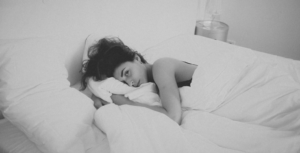If you’ve ever experienced sleep paralysis, you already know how disturbing it can be. But understanding this phenomenon can help put your mind at ease if it happens again. In this article, we’ll cover what sleep paralysis is, what tends to cause it, how to prevent it, and how to use it to help you have lucid dreams.
What is Sleep Paralysis?
Though I’m not a Sleep Doctor, I do work in Sleep Medicine. And based on my training and experience, I like to use 3 different perspectives to describe sleep paralysis:
- The clinical perspective
- The subjective perspective
- The lucid dreamer’s perspective
1. A clinical understanding of sleep paralysis
During Rapid Eye Movement (REM) sleep, muscle atonia (loss of muscle tone) occurs in the body to prevent us from acting our dreams out in bed. By comparison, people with REM Behavior Disorder do not have muscle atonia during REM, so they do act their dreams out by kicking, punching, shouting, flailing about in bed, etc.
 Physiologically, the muscle atonia (which is a temporary state of paralysis) during REM is normal, healthy, and useful. The problem occurs when psychologically, conscious awareness spontaneously reactivates and the sleeper wakes up, feeling trapped in their own body, unable to move.
Physiologically, the muscle atonia (which is a temporary state of paralysis) during REM is normal, healthy, and useful. The problem occurs when psychologically, conscious awareness spontaneously reactivates and the sleeper wakes up, feeling trapped in their own body, unable to move.
Sleep paralysis is classified as one of a few Parasomnias– “undesirable physical events or experiences that occur during the initiation of sleep, during sleep or during arousal from sleep”.
This particular parasomnia tends to occur during one of two transitional stages of sleep:
The Hypnagogic State
This is an intermediate state of transition from wake to sleep. This occurs during sleep onset and immediately following brief awakenings throughout the night. So if you wake up at some point in your sleep cycle, during the night, you’ll go into a hypnagogic state before fully falling back to sleep. It’s considered a threshold state of consciousness and includes hallucinations, and lucid thought, which we will get to shortly.
The sleep paralysis hallucinations that occur in this mental state are actually called hypnagogic hallucinations.
- Hypnagogia is the experience of the transitional state between wake and sleep… or commonly in the case of sleep paralysis; between REM and nonREM sleep – it’s a temporary step between the more concrete states of consciousness.
Greek origin: Hypnos = “Sleep”, and Gogic = “to enter into”
The Hypnopompic State
Subjectively, the hypnopompic transitional state is quite similar to the hypnagogic, but rather than occurring at sleep onset, it occurs just before waking up.
Greek origin: Hypnos = “Sleep” and Pompe = “Send away” or “to lead out”
In these grey-areas of sleep, people experience a blurring of waking reality and dream reality. The mind is almost fully awake but asleep enough to generate dream-like hallucinations, commonly described as nightmare-like hallucinations.
2. What is Sleep Paralysis like?
Although these experiences are short-lived, they can be quite unsettling. Episodes of sleep paralysis typically entail waking up but being completely unable to move one’s body.
And if that’s not disturbing enough, in addition to being unable to move, the experience often includes vivid hallucinations.
When people experience this phenomenon, AND they experience muscle atonia, they tend to become afraid. The fear centers of the brain become hyperactive, creating terrifying hallucinations that can manifest in the following ways:
Types of hypnagogic hallucinations
-
- Visual: People often report seeing threatening or frightening figures in the room. These figures can appear as demons, aliens, or malevolent people. They might appear to be looming nearby or even right on top of the sleeping individual.

- Auditory: Sounds of footsteps in the room, doors opening and closing, loud buzzing, or humming, or even voices have all been reported during these episodes.
- Physical: These can include a sense of pressure or weight, sometimes accompanied by the image of a demon sitting on the chest. It can feel like being strangled, drowning, or suffocating, but it’s all in the mind.
- Vestibular-motor: This kind of hypnagogic hallucination involves a sense of movement. It can feel like floating or hovering above the bed, sometimes out-of-body. Sometimes it’s like being pulled through a hallway, falling, spinning, or rolling around in the bed. Actually, many reported alien abductions are explained by sleep paralysis episodes.
- Visual: People often report seeing threatening or frightening figures in the room. These figures can appear as demons, aliens, or malevolent people. They might appear to be looming nearby or even right on top of the sleeping individual.
3. Sleep paralysis for lucid dreamers
Now, if you are a lucid dreamer in training, or just aspiring to have lucid dreams, sleep paralysis is actually quite useful. If you experience something along the lines of what I’ve just described above, this means you’re conscious during a transitional phase of sleep. And if your goal is to be consciously aware  during a dream, well, you’re almost there, and you can think of sleep paralysis as a portal leading you to the lucid state.
during a dream, well, you’re almost there, and you can think of sleep paralysis as a portal leading you to the lucid state.
The whole ordeal won’t last more than a few minutes, and in most cases, it only lasts a few seconds. If you see sleep paralysis demons or scary people, remember they’re not real. Remind yourself that, despite whatever strangeness the experience entails, it is completely safe, temporary, and normal.
You just happen to be conscious when usually you’d be unconscious and you’re about to transition into REM sleep. So, rather than learning how to stop sleep paralysis, you can embrace it and use your awareness as a springboard to launch you into right into a lucid dream.
Try meditating in the hypnagogic states to induce lucidity
If you know how to meditate, try one of your favorite forms of meditation when you’re half asleep. The intentional focus involved in the exercise should help you maintain awareness as you drift back into sleep. This is can be a quick and easy way to get lucid.
Use sleep paralysis to practice mindfulness
Sleep paralysis also a great opportunity to utilize mindfulness techniques and practices. The more react in fear, the worse the experience will be for you. But if you stay calm, focus on the breath, and observe this unusual state with curiosity, it’ll be much more pleasant.
If you have a sleep paralysis episode, I recommend embracing it and using this time to be mindful and leading you into a lucid dream.
 Concentrate on your breathing and try to breathe deliberately and slowly. This is what we do in meditation… So if you have been listening to the guided lessons in Mind Awake, just apply what you already know – stay focused, and let the breath keep you anchored.
Concentrate on your breathing and try to breathe deliberately and slowly. This is what we do in meditation… So if you have been listening to the guided lessons in Mind Awake, just apply what you already know – stay focused, and let the breath keep you anchored.
What causes sleep paralysis?
There are many reasons you might awaken within the hypnagogic state and feel paralyzed in bed. Check out the neuroscience of sleep paralysis here. These episodes might not always be preventable, but understanding the causes can help you take steps to manage it if you have an unexpected episode.
Here are some common causes of sleep paralysis:
Often genetic/hereditary
Research shows that sleep paralysis can actually be hereditary. This twin and molecular genetics study found there was a moderate genetic influence on the phenomenon.
It’s more likely to occur in adolescents & young adults
Like sleepwalking, sleep paralysis can be thought of as a malfunctioning brain process. Malfunctions like these are more likely when the brain is still growing and developing in the areas associated with state shifts from wake to sleep, and light sleep to deep sleep/REM sleep. If you have occasional episodes and you’re under 25 years old, it’s likely you’ll simply outgrow it.
Very common in people with Narcolepsy
Narcolepsy, a sleep disorder characterized by moderate to severe daytime sleepiness and sudden ‘sleep attacks’. One type of narcolepsy includes a condition called cataplexy which is a sudden loss of muscle tone, usually triggered by strong emotions.
This loss of muscle tone is not entirely unlike the muscle atonia experienced in sleep paralysis. In fact, it’s quite common for narcoleptics to experience sleep paralysis with hallucinations as they’re falling asleep, and as they’re waking up.
If you experience sleep paralysis quite frequently, it doesn’t mean you have narcolepsy, so don’t freak out, but it can’t hurt to let your doctor know.
Poor sleep hygiene
For many reasons, it’s important to maintain healthy Sleep Hygiene. One reason is that poor sleep habits and sleep deprivation can increase your chances of having sleep paralysis episodes. In part, this is because transitioning sleep stages is a finely tuned, complex operation in the brain.
So, the more instability you have in your sleep schedule, the more likely it is that the brain will malfunction.
So think of sleep paralysis as an irregularity; spontaneous, unwanted awareness during a transitional phase of sleep. Then, the resolution should be clear: practice healthy sleep hygiene and aim to get better sleep.
Medical and mental health conditions
Similar to poor sleep hygiene, mental health disorders can contribute to parasomnias. Risk factors include anxiety, depression, post-traumatic stress disorder, panic disorder, lack of sleep, sleep apnea, and insomnia can all lead to sleep paralysis episodes.
Mental health conditions strongly affect sleep patterns, and as we know, poor sleep patterns lead to sleep paralysis and poor mental health during the day.
How do I deal with sleep paralysis?
Generally, sleep paralysis experiences are much worse in those who have no idea what’s happening to them. They become confused, helpless, and terrified. But, now that you know the basics about this eerie phenomenon, you’re already at an advantage if you experience it for yourself.
To try to prevent sleep paralysis from happening, make sure to optimize your sleep hygiene and let your brain and body rest when they need to.
But, if you wake up in bed and you see sleep paralysis demons, scary figures or have any of the above hallucinations, remember what we covered in this article, and keep these things in mind:
Sleep paralysis is completely…
- Safe because it’s all happening as a sort of side-effect of the mind doing its normal, natural thing, but with unwanted lucidity or awareness… it may seem like it can hurt you, but it cannot.
- Normal because at the level of the brain and body, it happens every single night. It functions to keep the body from acting out what the mind is generating during REM sleep. And if you’re lucid but you’re not quite in REM sleep yet, you’re sure to enter REM or wake very soon, which brings us to our next point.
- Temporary because it is a transitional phase. The brain is getting ready to shift from one state to the next. This doesn’t happen all at once, it’s a complex process and it sometimes takes a moment to shift into the next sleep stage.
So, have you had experiences like this? Let us know in the comments!

